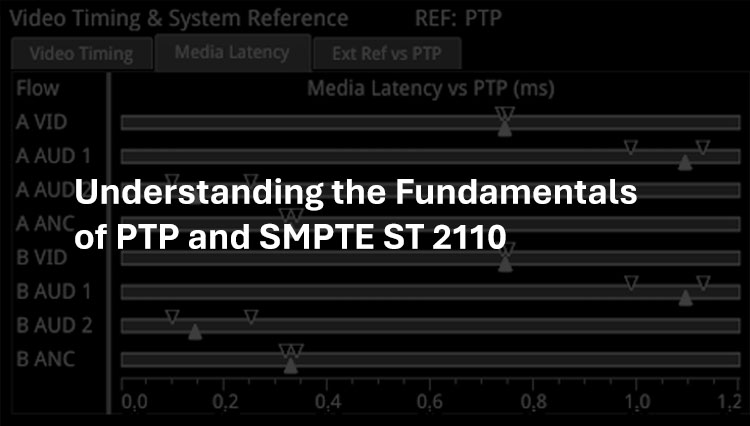This blog post explores the core principles of Precision Time Protocol (PTP) and its integral role in SMPTE ST 2110, the standard for professional media over managed IP networks.
The Need for Synchronization in IP Video Networks
Traditional SDI facilities rely on a single cable to carry video, audio, and ancillary data. This inherent synchronization simplifies signal management. However, as the industry transitions towards IP-based workflows, these essence streams are transmitted as separate IP Flows. This shift introduces the challenge of synchronizing these independent IP flows to ensure they arrive and are processed in time and with each other and in the correct order, preserving the intended viewing experience.
Enter PTP: Precision Timing for Media Professionals
PTP, as defined by the IEEE 1588 standard, offers a solution to this challenge. It’s a specialized protocol designed to achieve highly accurate clock synchronization across a network. Unlike general-purpose protocols like NTP, PTP provides the sub- (μ) microsecond-level precision essential for professional media applications.
Key Concepts of PTP
PTP Architecture and Operation
PTP utilizes a hierarchical architecture to distribute timing information throughout a network:
- Grand Master Clock: The ultimate source of time for the entire network. Ideally, this clock is locked to a highly stable reference, such as GPS or a Cesium atomic clock.
- Leader Clock: Receives timing information from the Grand Master Clock and distributes it to connected devices.
- Follower Clock: Synchronizes its clock to the timing information received from a Leader Clock.
- Boundary Clock: A special type of clock that resides on a network switch. It acts as both a Follower Clock to an upstream Leader Clock and a Leader Clock to downstream devices, effectively segmenting the network and reducing the load on the Grand Master Clock.
- Transparent Clock: Also residing on a network switch, this clock measures the residence time of each PTP packet passing through it and adds this delay information to a correction field. While simpler to implement than Boundary Clocks, they are less suitable for large-scale systems due to scalability limitations.
SMPTE ST 2059: Optimizing PTP for Broadcast Networks
SMPTE ST 2059 defines profiles that refine PTP operation specifically for broadcast networks. These profiles ensure that video and audio signals maintain precise phase alignment at any given time. This is crucial for preventing timing errors that could lead to noticeable audio-video discrepancies and impact the viewer’s experience.
PTP Timing Modes: One-Step vs. Two-Step
PTP employs two primary methods for calculating timing parameters:
- One-Step Mode: The Leader Clock sends a single message containing the precise time of transmission, enabling the Follower Clock to immediately calculate network delay and offset. While simpler, this method can be affected by asymmetric network delays, where data packets take different paths and experience varying latency.
- Two-Step Mode: Addresses the limitations of One-Step Mode by introducing a Follow-Up message after the initial Sync message. This provides the Follower Clock with a more accurate timestamp, allowing it to compensate for variations in network delay. Two-Step Mode is generally preferred in networks with potential for asymmetric delays, such as those employing redundancy protocols like PRP and HSR.
Maintaining a Robust PTP Network
Best Master Clock Algorithm (BMCA)
BMCA is a critical component of PTP that ensures network resilience. It automatically selects the best Leader Clock on the network to act as the Grand Master, based on factors like clock accuracy, variance, and user-defined priorities. This mechanism guarantees that even if the designated Grand Master Clock experiences issues, a suitable backup will automatically take over, minimizing disruptions to the synchronization system.
PTP Domains: Isolating Timing Systems
PTP Domains allow the coexistence of multiple independent timing systems within the same physical network. Each PTP message includes a Domain Number, enabling devices to selectively process messages from their assigned domain while ignoring others. This is particularly useful in facilities where different systems, such as SMPTE ST 2110 video and AES67 audio, operate concurrently. By assigning each system to a separate PTP Domain, potential conflicts between their specific timing requirements are avoided.
Backwards Compatibility: Embracing the Evolution of PTP
The latest iteration of the PTP standard, IEEE 1588-2019 (PTP Version 2.1), introduces new features and enhancements while maintaining backward compatibility with previous versions. This ensures that newer devices can integrate seamlessly into existing PTP networks without disrupting ongoing operations.
Key Features of PTP Version 2.1
PTP Version 2.1 introduces advancements like Multi-Master PTP and Hybrid Operation, enhancing the robustness and flexibility of synchronization systems. These features improve accuracy, fault tolerance, and support for diverse network topologies, paving the way for future-proof solutions for media synchronization.
Conclusion
PTP forms the foundation of synchronization for professional IP video networks, and SMPTE ST 2110 leverages its capabilities to guarantee seamless media workflows. As the industry continues its transition to IP, understanding the intricacies of PTP, and particularly its application in SMPTE ST 2110, is paramount for anyone involved in designing, deploying, and maintaining high-quality, synchronized media systems.
Interested in learning more about PTP and ST 2110? Watch our latest webinar “PTP Take 3” where Gerard Phillips (Arista), Steve Holmes and Kevin Salvidge (Leader) answer a range of questions concerning PTP and SMPTE 2110 deployments.

